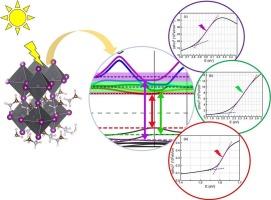碘化铅甲基铵钙钛矿太阳能电池吸收系数及载流子产生的综合研究
IF 4.6
2区 物理与天体物理
Q2 MATERIALS SCIENCE, MULTIDISCIPLINARY
引用次数: 0
摘要
本文研究了甲基碘化铅(MAPbI3)钙钛矿太阳能电池的光子吸收机理和载流子产生速率。载流子的产生速率受入射光强度、材料的吸收系数和表面反射率的影响。通过回顾不同研究人员的实验结果,我们提出了钙钛矿结构中吸收系数的理论。该理论基于能带结构计算和通过DFT导出的态密度(DOS)图,解释了吸收系数作为入射光子能量函数的行为,并提供了一个准确、实用且相对简单的模型。在该模型中,吸收系数对入射光子能量的依赖性与MAPbI3钙钛矿能带结构中确定的三个不同的能隙有关,从而导致这种依赖性的三范围表示。此外,由吸收系数推导出消光系数与光子能量的关系。最后,应用该模型计算了载流子的产生随光子能量的变化。这项研究提供的见解增强了我们对吸收机制的理解,并为优化钙钛矿太阳能电池提供了途径,通过瞄准光子光谱中的特定能量范围。本文章由计算机程序翻译,如有差异,请以英文原文为准。

Comprehensive study of absorption coefficient and charge carrier generation in methylammonium lead iodide perovskite solar cells
This study investigates the mechanisms of photon absorption and the rate of charge carrier generation in methylammonium lead iodide (MAPbI3) perovskite solar cells. Charge carrier generation rates are influenced by incident light intensity, the material’s absorption coefficient, and its surface reflectivity. By reviewing experimental results from various researchers, we propose a theory for the absorption coefficient in these perovskite structures. This theory, based on band structure calculations and density of states (DOS) diagrams derived via DFT, explains the behavior of the absorption coefficient as a function of the incident photon’s energy and provides an accurate, practical, and relatively simple model. In this model, the dependence of the absorption coefficient on the incident photon energy is linked to three distinct energy gaps identified in the MAPbI3 perovskite band structure, leading to a three-range representation for this dependency. Additionally, the relationship between the extinction coefficient and photon energy is derived from the absorption coefficient. Finally, this new model is applied to calculate the charge carrier generation as a function of photon energy. The insights provided by this study enhance our understanding of absorption mechanisms and offer pathways for optimizing perovskite solar cells by targeting specific energy ranges in the photon spectrum.
求助全文
通过发布文献求助,成功后即可免费获取论文全文。
去求助
来源期刊

Results in Physics
MATERIALS SCIENCE, MULTIDISCIPLINARYPHYSIC-PHYSICS, MULTIDISCIPLINARY
CiteScore
8.70
自引率
9.40%
发文量
754
审稿时长
50 days
期刊介绍:
Results in Physics is an open access journal offering authors the opportunity to publish in all fundamental and interdisciplinary areas of physics, materials science, and applied physics. Papers of a theoretical, computational, and experimental nature are all welcome. Results in Physics accepts papers that are scientifically sound, technically correct and provide valuable new knowledge to the physics community. Topics such as three-dimensional flow and magnetohydrodynamics are not within the scope of Results in Physics.
Results in Physics welcomes three types of papers:
1. Full research papers
2. Microarticles: very short papers, no longer than two pages. They may consist of a single, but well-described piece of information, such as:
- Data and/or a plot plus a description
- Description of a new method or instrumentation
- Negative results
- Concept or design study
3. Letters to the Editor: Letters discussing a recent article published in Results in Physics are welcome. These are objective, constructive, or educational critiques of papers published in Results in Physics. Accepted letters will be sent to the author of the original paper for a response. Each letter and response is published together. Letters should be received within 8 weeks of the article''s publication. They should not exceed 750 words of text and 10 references.
 求助内容:
求助内容: 应助结果提醒方式:
应助结果提醒方式:


